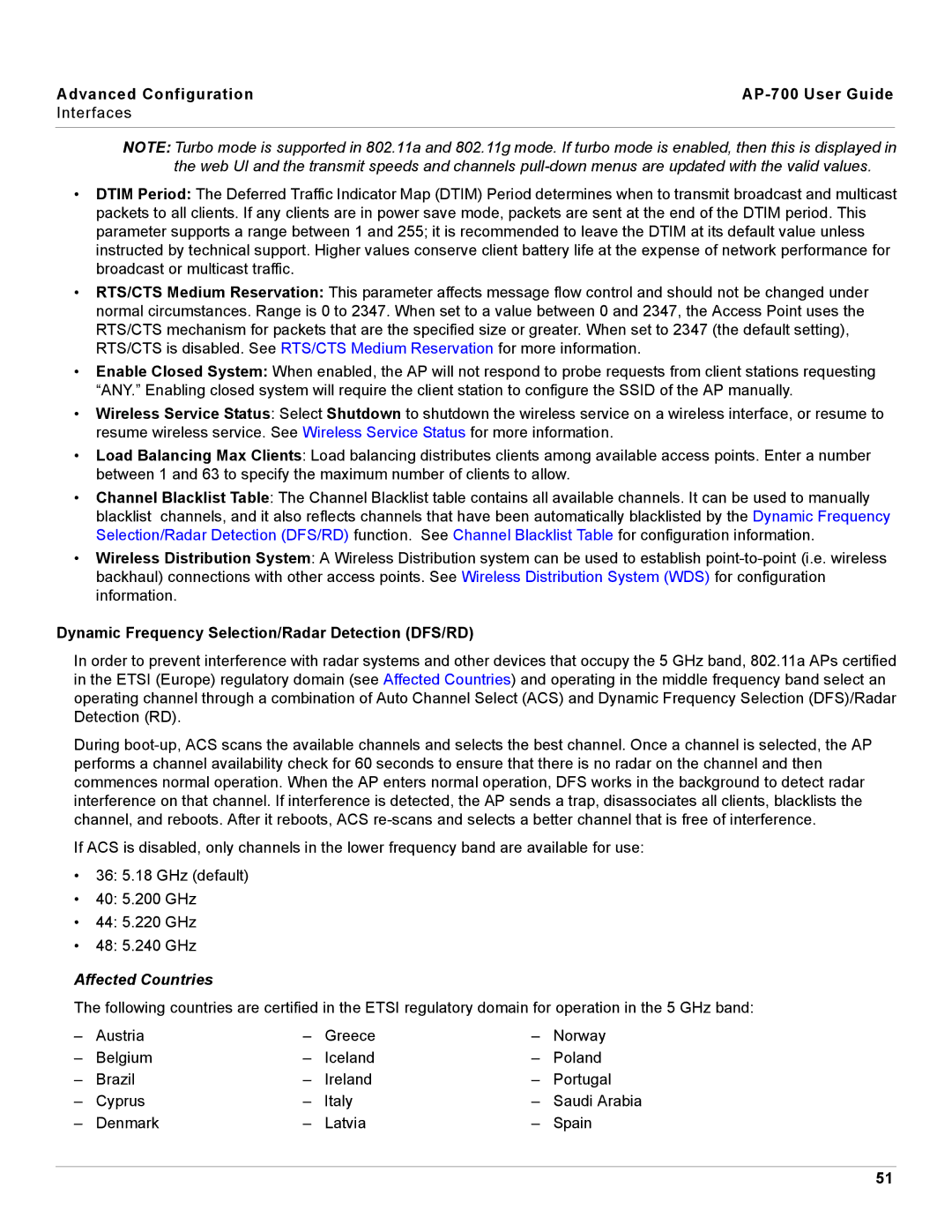
Advanced Configuration |
|
Interfaces
NOTE: Turbo mode is supported in 802.11a and 802.11g mode. If turbo mode is enabled, then this is displayed in the web UI and the transmit speeds and channels
•DTIM Period: The Deferred Traffic Indicator Map (DTIM) Period determines when to transmit broadcast and multicast packets to all clients. If any clients are in power save mode, packets are sent at the end of the DTIM period. This parameter supports a range between 1 and 255; it is recommended to leave the DTIM at its default value unless instructed by technical support. Higher values conserve client battery life at the expense of network performance for broadcast or multicast traffic.
•RTS/CTS Medium Reservation: This parameter affects message flow control and should not be changed under normal circumstances. Range is 0 to 2347. When set to a value between 0 and 2347, the Access Point uses the RTS/CTS mechanism for packets that are the specified size or greater. When set to 2347 (the default setting), RTS/CTS is disabled. See RTS/CTS Medium Reservation for more information.
•Enable Closed System: When enabled, the AP will not respond to probe requests from client stations requesting “ANY.” Enabling closed system will require the client station to configure the SSID of the AP manually.
•Wireless Service Status: Select Shutdown to shutdown the wireless service on a wireless interface, or resume to resume wireless service. See Wireless Service Status for more information.
•Load Balancing Max Clients: Load balancing distributes clients among available access points. Enter a number between 1 and 63 to specify the maximum number of clients to allow.
•Channel Blacklist Table: The Channel Blacklist table contains all available channels. It can be used to manually blacklist channels, and it also reflects channels that have been automatically blacklisted by the Dynamic Frequency Selection/Radar Detection (DFS/RD) function. See Channel Blacklist Table for configuration information.
•Wireless Distribution System: A Wireless Distribution system can be used to establish
Dynamic Frequency Selection/Radar Detection (DFS/RD)
In order to prevent interference with radar systems and other devices that occupy the 5 GHz band, 802.11a APs certified in the ETSI (Europe) regulatory domain (see Affected Countries) and operating in the middle frequency band select an operating channel through a combination of Auto Channel Select (ACS) and Dynamic Frequency Selection (DFS)/Radar Detection (RD).
During
If ACS is disabled, only channels in the lower frequency band are available for use:
•36: 5.18 GHz (default)
•40: 5.200 GHz
•44: 5.220 GHz
•48: 5.240 GHz
Affected Countries
The following countries are certified in the ETSI regulatory domain for operation in the 5 GHz band:
– | Austria | – | Greece | – | Norway |
– | Belgium | – | Iceland | – | Poland |
– | Brazil | – | Ireland | – | Portugal |
– | Cyprus | – | Italy | – | Saudi Arabia |
– | Denmark | – | Latvia | – | Spain |
51
